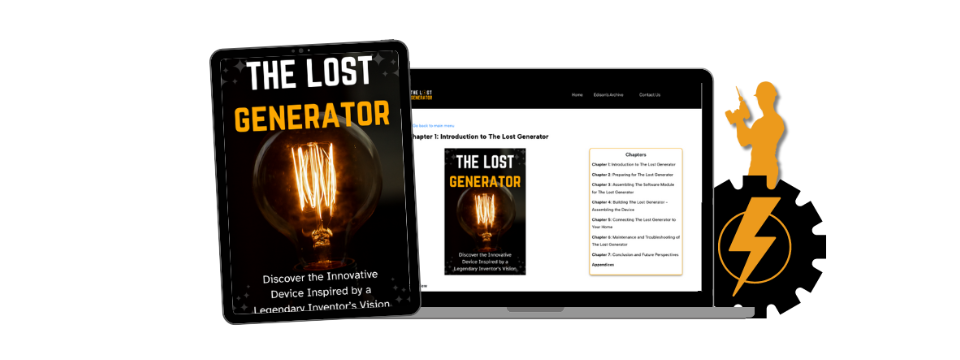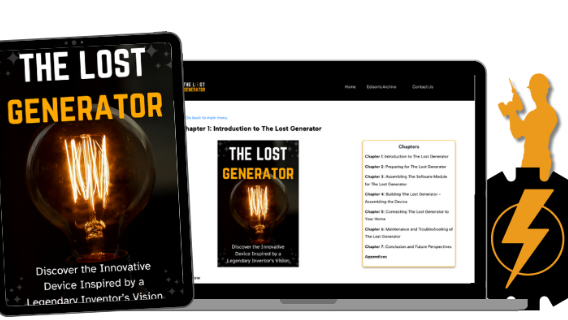The Lost Generator | Member area and video courses
Introduction to the Lost Generator
The Lost Generator represents a fascinating chapter in the history of energy generation, blending historical significance with innovative design. This device, which has largely faded from public awareness, embodies the engineering marvels of earlier epochs, drawing inspiration from the visionaries who paved the way for modern electrical systems. Unlike conventional energy sources that depend on fossil fuels or large-scale hydroelectric projects, the Lost Generator operates on principles derived from the foundational aspects of electromagnetism and mechanical engineering, setting it apart as a unique contributor to the understanding of electricity The Lost Generator generation.

At its core, the Lost Generator operates on the principles of electromagnetic induction, a concept first demonstrated by Michael Faraday in the 19th century. Faraday’s discoveries laid the groundwork for countless electrical innovations, leading to devices that not only produce electricity but also highlight the importance of efficiency and sustainability. By utilizing minimal materials, the Lost Generator is an accessible model for enthusiasts and scholars alike, illustrating how ingenuity can harness energy in practical yet innovative ways The Lost Generator.
The allure of constructing a generator inspired by the inventive spirits of the past is significant for both educational and recreational purposes. This endeavor not only enables hands-on learning about basic electrical principles but also fosters critical thinking and problem-solving skills. As individuals engage with the construction and functionality of the Lost Generator, they gain valuable insights into the interconnectedness of history, technology, and the environment. This multifaceted educational experience encourages a deeper appreciation for earlier innovations while inspiring the exploration of how they can be adapted for contemporary applications. Thus, the Lost Generator stands as a testament to human ingenuity and an invitation to explore the endless possibilities of energy generation.
Step-by-Step Guide to Building Your Own Edison Generator
Constructing your own Edison Generator is a rewarding educational project that encourages creativity and engagement with practical science. Below is a step-by-step guide detailing the materials, tools, and instructions needed to successfully build the device. This guide has been crafted with accessibility in mind, ensuring individuals with no prior experience can follow along.

Materials Required:
- Wire: 24-gauge copper wire (approximately 200 feet)
- Magnet: A strong neodymium magnet, preferably 1-inch in diameter
- Wooden Base: A sturdy piece of plywood, around 12 inches by 12 inches
- Ruler: For measurement
- Tube: A non-metallic tube, about 1 inch in diameter and 6 inches in length
- Light bulb: A small LED light bulb
- Battery: A 9-volt battery for powering the light
- Electrical tape: To secure connections
- Tools: Wire cutters, soldering iron, and a drill

Instructions:
- Prepare the Base: Start by laying the plywood flat on a work surface. This plywood will serve as the foundation for your generator.
- Connect the Wire: Cut lengths of copper wire between 15 to 20 feet long. Wrap these wires around the tube, leaving about 2 feet of wire free at either end for connections.
- Attach the Magnet: Secure the neodymium magnet to the center of the tube using electrical tape, ensuring it is firmly in place.
- Creating Electricity: Insert the tube into a vertical position on the wooden base, allowing the magnet to freely spin when rotated. Ensure the winding is tight for efficiency.
- Connect the Light Bulb: Attach one end of the wire to the light bulb and the other to the battery. This will allow you to test the generator’s functionality.
- Test the Device: By spinning the tube and magnet, you will be able to generate electricity that will power the LED light bulb.
For visual references, it is highly recommended to consult online diagrams and illustrations, as these can significantly enhance your understanding of the assembly process. Building this generator using materials from local hardware stores demonstrates the accessibility of hands-on learning in the field of environmental science and renewable energy. Be sure to take proper precautions when using tools and working with electricity.
Educational Benefits of the Edison Generator
The Edison Generator serves as a rich educational tool, enabling students and enthusiasts to engage deeply with concepts related to alternative energy generation and electrical engineering. Constructing and utilizing this generator provides a hands-on learning experience that effectively links theoretical principles with practical application. As learners work through the various stages of building the generator, they tackle fundamental electrical principles such as voltage, current, and resistance, reinforcing their understanding through direct application.
Moreover, this project fosters critical problem-solving skills. Encountering challenges during construction or operation prompts students to think analytically and troubleshoot effectively. These experiences cultivate resilience and encourage innovative thinking, key attributes in both academic settings and real-world applications. The process of iterating on their designs to improve efficiency or rectify faults enhances their engineering acumen.

In addition to electrical principles, the Edison Generator aligns with contemporary educational frameworks focused on sustainability. By exploring how the generator operates as a clean energy source, students gain insight into renewable energy technologies, which are increasingly vital in today’s landscape. This exploration promotes an understanding of sustainability practices, highlighting the importance of transitioning towards cleaner energy solutions. Furthermore, the educational experience extends beyond the mechanics of the generator itself, encouraging discussions around the environmental impacts of traditional energy sources and the potential benefits of implementing alternative technologies.
This immersion into renewable energy fosters a sense of environmental awareness among students, positioning them as informed citizens ready to tackle the pressing energy challenges of the future. By diving into the mechanics and implications of the Edison Generator, learners not only enhance their technical knowledge but also develop a lifelong commitment to sustainable practices that benefit the planet.
Real-World Applications and Emergency Preparedness
The Edison Generator presents numerous practical applications, particularly relevant in today’s increasingly unpredictable world. One of its most crucial benefits lies in its ability to provide backup power during unexpected outages. Whether due to severe weather, natural disasters, or grid failures, the generator ensures that essential appliances and devices remain operational, safeguarding not only convenience but also crucial communications and safety measures. This aspect is especially vital for individuals residing in remote locations who may lack immediate access to traditional power sources.


Moreover, the generator supports energy independence. Off-grid living is a growing lifestyle choice for many, driven by a desire for sustainability and a reduced carbon footprint. The Edison Generator allows users to harness renewable energy sources, thereby mitigating reliance on fossil fuels or conventional electricity sources. Its adaptability promotes energy resilience, enabling users to generate power sustainably, regardless of external circumstances.
Numerous testimonials illustrate the positive impact of building and utilizing the Edison Generator. For instance, one individual living in a rural area recounted how their generator became a lifeline during an extended power outage caused by a severe storm. The ability to keep essential equipment running, including refrigerators and medical devices, prevented significant hardships. Another user highlighted their experience with energy independence, mentioning that their generator complemented solar energy systems beautifully, enabling an efficient and sustainable power solution. These stories underlie the educational value of the project, emphasizing not only the engineering skills developed during the construction but also the practical skills necessary for effective emergency preparedness.
Incorporating the Edison Generator into emergency preparedness plans can offer substantial peace of mind, affirming its value as a vital resource in both unexpected situations and everyday life.



